| Article ID | Journal | Published Year | Pages | File Type |
|---|---|---|---|---|
| 5513673 | Methods | 2016 | 13 Pages |
Abstract
Detection of superoxide produced by living cells has been an on-going challenge in biology for over forty years. Various methods have been proposed to address this issue, among which spin trapping with cyclic nitrones coupled to EPR spectroscopy, the gold standard for detection of radicals. This technique is based on the nucleophilic addition of superoxide to a diamagnetic cyclic nitrone, referred to as the spin trap, and the formation of a spin adduct, i.e. a persistent radical with a characteristic EPR spectrum. The first application of spin trapping to living cells dates back 1979. Since then, considerable improvements of the method have been achieved both in the structures of the spin traps, the EPR methodology, and the design of the experiments including appropriate controls. Here, we will concentrate on technical aspects of the spin trapping/EPR technique, delineating recent breakthroughs, inherent limitations, and potential artifacts.
Keywords
BMPOGPXGSHHRPNBTDCFH2PMNsSCEphorbol 12-myristate 13-acetatefMLPDEPMPOTAMsAMPOPBSDTPADMPOXDIPPMPO5-diethoxyphosphoryl-5-methyl-1-pyrroline N-oxideN-formylmethionyl-leucyl-phenylalanineCFUDMPOEMPOnuclear magnetic resonance2-OH-E+2-hydroxyethidiumDFTPMANOxO2−ONOO−ROSHydrogen peroxideSuperoxide radical anionEthidiumESR spectroscopydiethylene triamine pentaacetic acidSaturated Calomel ElectrodeNADPH oxidasenitro blue tetrazoliumNMREPRSpin trappingIron-sulfur clustersHydroxyl radicalFree radicalSODSuperoxide dismutaseCyclodextrinEPR spectroscopypolymorphonuclear leukocytesMacrophagePhosphate-buffered salinecontinuous waveDensity functional theoryNitric oxideHemeproteinHydroethidineH2O2colony-forming unitHorseradish peroxidasePeroxynitritepolyethylene glycolPEGGlutathioneglutathione peroxidaseReactive oxygen species
Related Topics
Life Sciences
Biochemistry, Genetics and Molecular Biology
Biochemistry
Authors
Kahina Abbas, Nikola BabiÄ, Fabienne Peyrot,
